Intel Iris Pro 5200 Graphics Review: Core i7-4950HQ Tested
by Anand Lal Shimpi on June 1, 2013 10:01 AM ESTCompute Performance
With Haswell, Intel enables full OpenCL 1.2 support in addition to DirectX 11.1 and OpenGL 4.0. Given the ALU-heavy GPU architecture, I was eager to find out how well Iris Pro did in our compute suite.
As always we'll start with our DirectCompute game example, Civilization V, which uses DirectCompute to decompress textures on the fly. Civ V includes a sub-benchmark that exclusively tests the speed of their texture decompression algorithm by repeatedly decompressing the textures required for one of the game’s leader scenes. While DirectCompute is used in many games, this is one of the only games with a benchmark that can isolate the use of DirectCompute and its resulting performance.
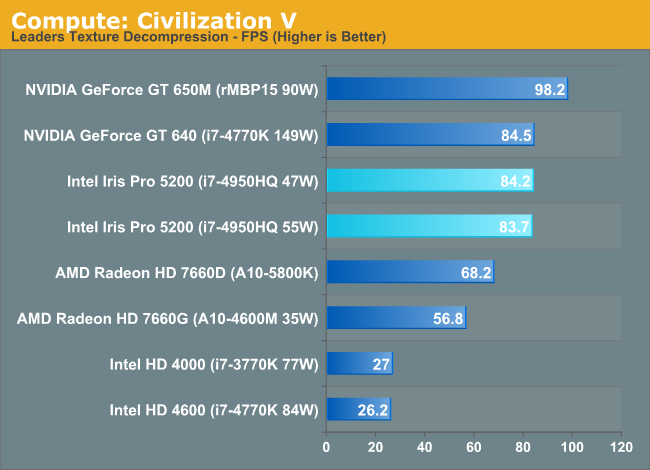
Iris Pro does very well here, tying the GT 640 but losing to the 650M. The latter holds a 16% performance advantage, which I can only assume has to do with memory bandwidth given near identical core/clock configurations between the 650M and GT 640. Crystalwell is clearly doing something though because Intel's HD 4600 is less than 1/3 the performance of Iris Pro 5200 despite having half the execution resources.
Our next benchmark is LuxMark2.0, the official benchmark of SmallLuxGPU 2.0. SmallLuxGPU is an OpenCL accelerated ray tracer that is part of the larger LuxRender suite. Ray tracing has become a stronghold for GPUs in recent years as ray tracing maps well to GPU pipelines, allowing artists to render scenes much more quickly than with CPUs alone.
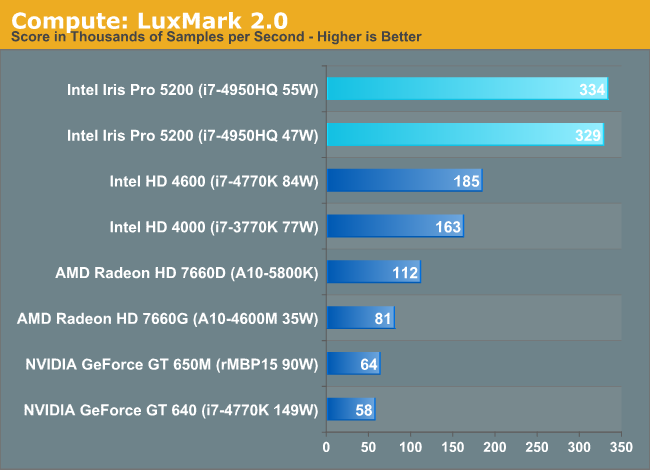
Moving to OpenCL, we see huge gains from Intel. Kepler wasn't NVIDIA's best compute part, but Iris Pro really puts everything else to shame here. We see near perfect scaling from Haswell GT2 to GT3. Crystalwell doesn't appear to be doing much here, it's all in the additional ALUs.
Our 3rd benchmark set comes from CLBenchmark 1.1. CLBenchmark contains a number of subtests; we’re focusing on the most practical of them, the computer vision test and the fluid simulation test. The former being a useful proxy for computer imaging tasks where systems are required to parse images and identify features (e.g. humans), while fluid simulations are common in professional graphics work and games alike.
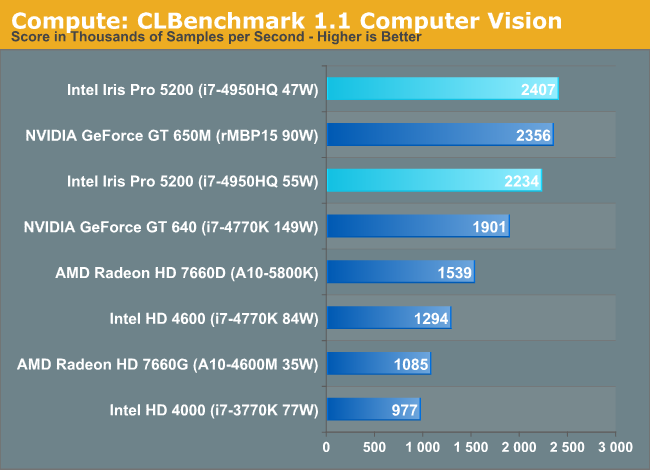
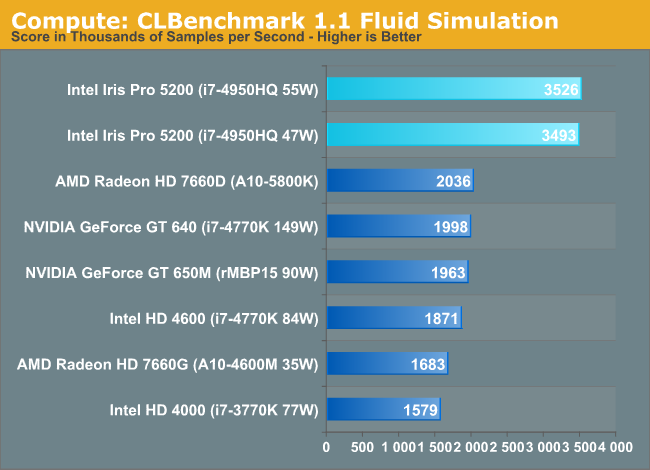
Once again, Iris Pro does a great job here, outpacing everything else by roughly 70% in the Fluid Simulation test.
Our final compute benchmark is Sony Vegas Pro 12, an OpenGL and OpenCL video editing and authoring package. Vegas can use GPUs in a few different ways, the primary uses being to accelerate the video effects and compositing process itself, and in the video encoding step. With video encoding being increasingly offloaded to dedicated DSPs these days we’re focusing on the editing and compositing process, rendering to a low CPU overhead format (XDCAM EX). This specific test comes from Sony, and measures how long it takes to render a video.
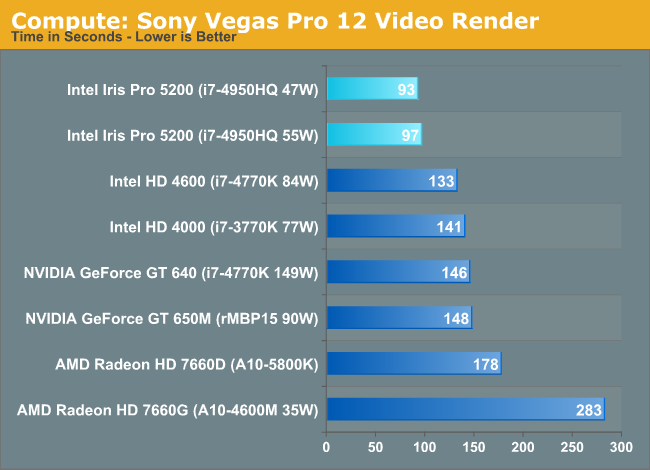
Iris Pro rounds out our compute comparison with another win. In fact, all of the Intel GPU solutions do a good job here.










177 Comments
View All Comments
whyso - Saturday, June 1, 2013 - link
They are completely different systems making power consumption values irrelevant.codedivine - Saturday, June 1, 2013 - link
Hi folks. Can you post the OpenCL extensions supported? You can use something like "GPU Caps viewer" from Geeks3d.tipoo - Saturday, June 1, 2013 - link
Interesting that the compute is punches above it's game performance weight. I wonder if they could put more EUs in a chip, maybe a larger eDRAM, and put it on a board as a compute card.lmcd - Saturday, June 1, 2013 - link
They already have a compute card called Xeon Phi if I remember correctly.Klimax - Sunday, June 2, 2013 - link
Different Arch (X86 in Phi)tipoo - Sunday, June 2, 2013 - link
I'm aware, but the Xeon Phi requires completely different programming than a GPU like this which can just use OpenCL.Soul_Master - Saturday, June 1, 2013 - link
What's your point for comparing desktop GPU with middle-range mobile GPU? CPU on both devices are not equal.Soul_Master - Saturday, June 1, 2013 - link
Sorry. I misunderstood about i7 4950HQ process, a high-end quad-core processor for laptops.Ryan Smith - Sunday, June 2, 2013 - link
It's what we had available. We wanted to test a DDR3 version of GK107, and that's what was on-hand.tipoo - Saturday, June 1, 2013 - link
Hmm, so it's heavily hinted at that the next rMBP will ditch discreet graphics. The 5200 is good, but that would still be a regression in performance. Not the first time Apple would have done that, there was the Radeon cut out of the Mini, the 320M to the 3000, even the bottom rung of the newest iMac with the 640m. I wonder if it would at least be cheaper to make up for it.